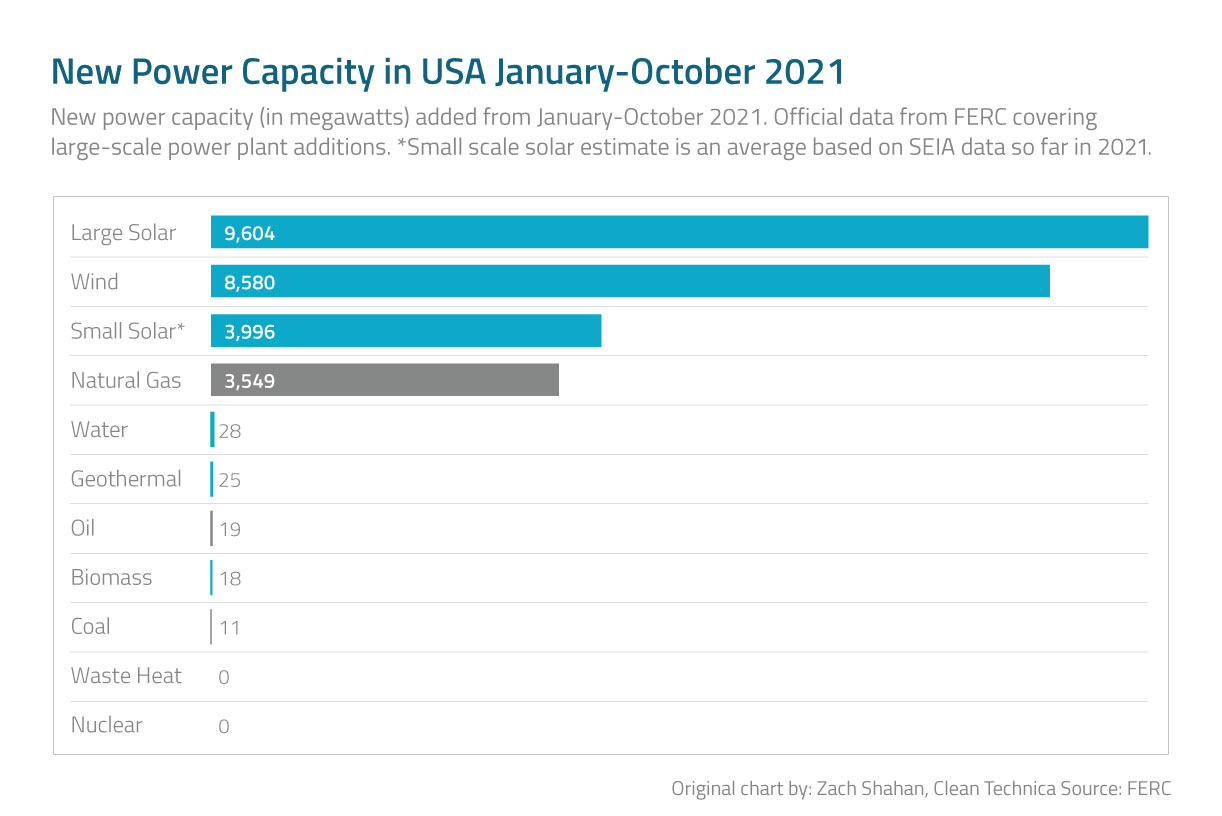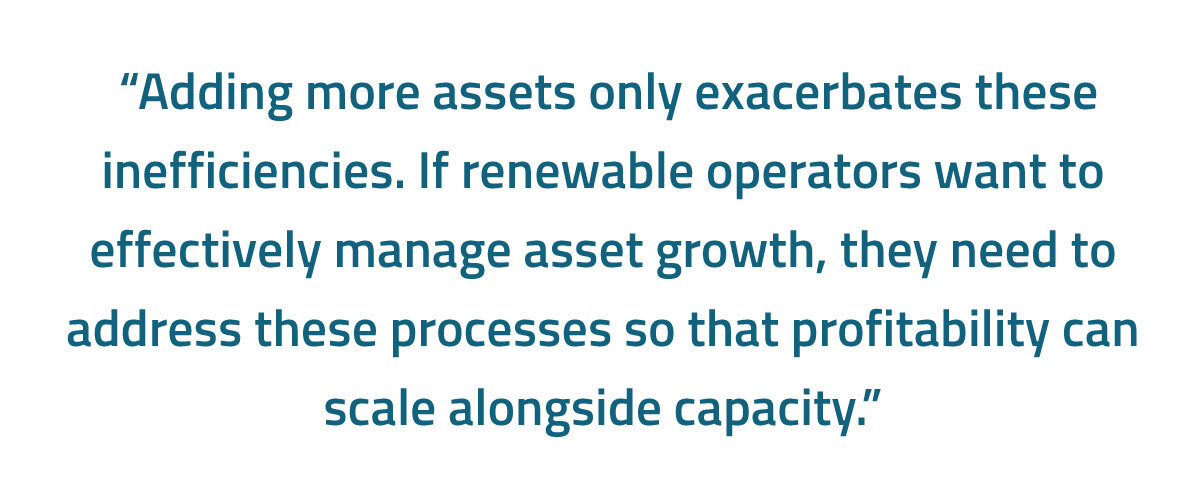Renewable Energy is Growing, but Intelligent Automation is Needed to Scale Effectively
The past few years have seen incredible growth in renewable energy installations.
CleanTechnica reported recently that, "In 2021, wind and solar power have absolutely dominated new power capacity additions, accounting for a whopping 85.9% of new US power capacity.”
In October of 2021, new wind and solar capacity was already at 22GW, with a significant prediction of installs in the end of 2021 indicating another year of extreme growth for renewable energy. CleanTechnica also stated that “large-scale solar accounted for 37.2% of new US power capacity in the first 10 months of 2021, wind power accounted for 33.2%, small-scale solar accounted for 15.5%, and fossil gas accounted for 13.7%."

In addition to the natural growth of renewable energy, President Biden has signed the $1.2 trillion Infrastructure bill into law, creating even more growth opportunities for renewable energy. This is fantastic for wind and solar operations, but can be disastrous if they aren’t prepared to efficiently handle the growth. Adding capacity just adds monitoring noise and often has engineers in reactive mode—dealing with unexpected downtime and repairs. If engineering isn’t highly efficient in how they manage assets, adding more assets requires adding more people and often results in more downtime. This means profit margins decrease as they grow. 
The best way to meet the demands of capacity growth efficiently is by going beyond monitoring to intelligent automation. This article will discuss why current monitoring doesn’t scale and how intelligent automation can fix it so you can grow with confidence.
Why today’s energy operations don’t scale efficiently:
A typical daily experience for an engineer managing renewable assets is:
-
-
- Log into multiple systems
- Try to manually spot issues & review alarms
- Investigate alarms to determine if they require action
- Create an analysis report
- Determine next steps
- Email people to share the report and assign action items
- Manually follow up on open cases to see if action was taken, repairs were made, if additional action is required, etc.
- Then repeat this process for each issue identified
-
This is a very reactive and time consuming process that has many points of potential breakdown.
For example, did the engineer:
-
-
- Manually spot all the issues?
- Investigate the highest priority issues?
- Determine the next steps that are most likely to solve the issue?
- Assign the action items to the right people?
- Share the information with everyone who needed it and follow up?
-
These inefficiencies are what add to asset downtime. Adding more assets only exacerbates these inefficiencies. If renewable operators want to effectively manage asset growth, they need to address these processes so that profitability can scale alongside capacity.
What is intelligent automation for energy operations?
Intelligent automation is software that removes the inefficiencies from asset management—both from the standpoint of technology and people processes. Here are some of the key features of intelligent automation that specifically remove operational inefficiencies.
-
- Single pane of glass - Intelligent automation integrates multiple data sources for a single view of monitoring data. This streamlines the process for the engineer and provides richer information since it is all located in one place, from a single login.
- Automated engineering processes - Instead of relying on engineers to manually detect, troubleshoot, and decide next step actions, intelligent automation focuses on automating this process so that engineers can focus on exceptions.
- Prioritizes issues - Intelligent automation brings to the surface the highest priority issues so that engineers don’t have to spend their time sifting through alerts. It also provides actionable insights and automates decisions so that investigation and validation are a simple process.
- Manages collaboration - Communication is one of the biggest inefficiencies of operations. Intelligent automation keeps all the right people informed and taking appropriate actions by putting actionable information right at their fingertips. This includes easy access to insights as to the best corrective actions and most likely root causes.
By automating both the human and technology of managing energy assets, the valuable time of engineers is better spent toward proactively managing potential issues—thereby reducing downtime.
How intelligent automation enables capacity growth
The engineering productivity improvements from intelligent automation enable operators to add capacity without adding engineers. It also allows for management to more effectively reduce downtime so that profit margins stay the same or better. Here are some of the results from renewable energy operators that have invested in intelligent automation:
-
- 99% reduction in alert volume that needs manual analysis
- 75% reduction in time to analyze issues
- 25% increase in analysis accuracy
- 90% reduction in asset downtime
The outcomes from intelligent automation are different for each operator depending upon the state of their asset management. Nevertheless, all operators experience these efficiencies to a significant scale. It’s easy to see how these drastic improvements are realized when you think about the tactical outcomes of intelligent automation:
-
- Engineers get less alert noise and can manage the important alerts they do get much more efficiently because they have appropriate context to quickly investigate.
- Engineers can catch issues sooner thanks to automation of detection and analytics.
- With earlier detection and predictive analytics, downtime can be reduced and consumption can be optimized.
Investing in intelligent automation creates tangible value that allows operators to scale efficiently. As new installations occur, it must be a priority to optimize operational efficiency or else the inefficiencies will be magnified.
How can Intelligent automation help your operations to scale efficiently?
Thanks to the incredible demand of renewable energy combined with the influx of investment from the U.S. government, it is a great time to scale operations. But if you are unsure if your operations are efficient enough to scale confidently, consider asking your team the following:
-
- Do you log into multiple monitoring systems to try to get a picture of performance?
- Do you get a high volume of useless alerts?
- Do you have the information you need to easily investigate and prioritize issues?
- Do you feel issues could “fall through the cracks”?
- How much time do you typically spend on communications to resolve issues?
- How often are delays caused by poor communication?
- Are you able to leverage our data to improve operations and processes?
If your team is answering yes to even a few of these questions, it makes sense to look further into intelligent automation. Improving efficiency helps you to scale, but the real value is in reducing downtime and improving asset performance in production. This is what really keeps profitability high—no matter how much generation you are managing.